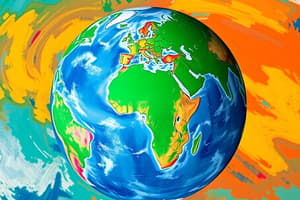Podcast
Questions and Answers
What is the primary function of a globe?
What is the primary function of a globe?
- To display the Earth's underground geological features
- To represent the Earth's surface as a sphere (correct)
- To provide a comprehensive view of the Earth's atmosphere
- To illustrate the Earth's rotation around the sun
Which continent is known for its diverse culture, history, and geography?
Which continent is known for its diverse culture, history, and geography?
- Australia
- Europe (correct)
- Africa
- Asia
What distinguishes Antarctica from the other continents?
What distinguishes Antarctica from the other continents?
- It has no permanent residents (correct)
- It is the warmest continent
- It is the second-largest continent
- It has the most diverse wildlife
Which continent covers about one-third of Earth's total land area?
Which continent covers about one-third of Earth's total land area?
Why is the globe considered an essential tool for students, teachers, and researchers?
Why is the globe considered an essential tool for students, teachers, and researchers?
What is one of the key aspects of the globe as a learning tool mentioned in the text?
What is one of the key aspects of the globe as a learning tool mentioned in the text?
What does the globe help students understand, according to the text?
What does the globe help students understand, according to the text?
In addition to geography and climate, what does the globe help learners visualize?
In addition to geography and climate, what does the globe help learners visualize?
What can students learn about by exploring the globe?
What can students learn about by exploring the globe?
Why is the globe considered a valuable tool for understanding the Earth?
Why is the globe considered a valuable tool for understanding the Earth?
Flashcards are hidden until you start studying
Study Notes
The Globe
The globe is a model of the Earth's surface, representing it as a sphere. It is a tool used to study and understand the planet's geography, climate, and other geological features. The globe serves as a visual representation of the Earth, providing a comprehensive view of its landmasses, oceans, and other important features.
Continents
The Earth is divided into seven major continents, each with its unique geographical features, climate, and inhabitants. These continents are:
- Asia: The largest continent, covering about one-third of Earth's total land area.
- Africa: The second-largest continent, with a wide range of climates and diverse wildlife.
- North America: Home to several major countries, including the United States.
- South America: The fourth-largest continent, with a mix of highlands, forests, and lowlands.
- Antarctica: The coldest, driest, and windiest continent, with no permanent residents.
- Europe: Known for its diverse culture, history, and geography.
- Australia: The smallest continent, with a unique landscape and rich wildlife.
Each of these continents is home to a variety of cultures, languages, and ecosystems, making them fascinating places to explore and learn about.
The Globe as a Learning Tool
The globe is an essential tool for students, teachers, and researchers, as it provides a visual representation of the Earth's features and allows for easy understanding of geographical concepts. Some key aspects of the globe as a learning tool include:
- Geography: The globe helps students understand the locations of different countries, cities, and landmarks, as well as the relationships between them.
- Climate: It allows for the study of climate patterns, weather systems, and natural disasters.
- Environment: The globe helps learners visualize the Earth's ecosystems, habitats, and biodiversity.
- Cultural Understanding: By exploring the globe, students can learn about the diverse cultures and histories of different regions.
In conclusion, the globe is a valuable tool for understanding the Earth's geography, climate, and ecosystems. By exploring the continents and other features on the globe, we can gain a deeper appreciation for the diverse and fascinating world we live in.
Studying That Suits You
Use AI to generate personalized quizzes and flashcards to suit your learning preferences.




